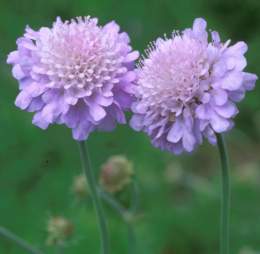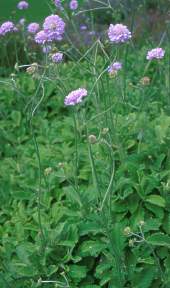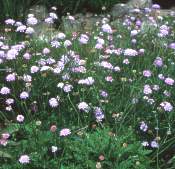Scabiosa africana
Scabiosa africana L.
Family: Dipsacaceae
Common names: Cape Scabious, Pincushion, Koringblom
Introduction
Seeing Scabiosa africana on the mountain, the first thought is that it must have escaped from a garden nearby. With its big mauve flowers and soft leaves, it looks just too tender and perfect to survive in the wild. But looks are misleading, for this beautiful perennial is perfectly happy in the fynbos, growing along the sheltered sandstone slopes of the Cape Peninsula.

Description
Description
Scabiosa africana grows fast, forming evergreen mounds of velvety leaves. Many thick stems shoot from the ground, bearing large rosettes of light green leaves. These big, soft and hairy leaves are oval shaped, about 160 mm long and 50 mm wide, with ruffled edges. From the leaves, the stems grow almost 1 m longer, dividing into side branches with the typical scabious flowers at the tips.
Flowering from spring to early summer, the plants are a beautiful sight with the many tall flowering stems waving in the wind. Looking at the flowers closely, one realizes that each head, which is about 50 mm across, is made up of many smaller flowers that vary in shades of mauve and white. After flowering, the heads turn into tight, bristly balls that fall apart as the seeds ripen.

Growing Scabiosa africana
Grow
Scabiosa africana is easy to grow in the garden and is a long-lasting cut flower. It requires full sun to semi-shade and good garden soil mixed with compost. New plants grow fast, flowering usually within their first year. Older plants tend to get untidy, but cut the old long woody stalks right back after flowering. This will encourage the plant to make many new shoots from the base. The plants tend to seed themselves quite happily in the garden.
New plants can be propagated from seed or cuttings. The seeds are inside the dried flowers and look like little badminton shuttlecocks. The seed can be sown in autumn or spring and will take about 3 weeks to germinate. The seedlings transplant easily and are hardy to winter cold. Cuttings can be made of new shoots from the bottom of the plant. Remove most of the big leaves and treat with a rooting hormone like Seradix 2.

The two other species grown at Kirstenbosch are Scabiosa incisa and Scabiosa colombaria, both of which have much smaller leaves than Scabiosa afticana.
Scabiosa colombaria (Bachelor's Buttons) is a small tufted perennial with white or mauve flowers, found widespread throughout Africa, Europe and Asia. The roots and leaves are used as a traditional medicine to treat colic and heartburn. The powdered roots are also used as a pleasant-smelling baby powder.
For the garden, the different forms of Scabiosa incisa are much more vigorous and exciting. Growing naturally on the coastal sands from Bokbaai to Grahamstown, it gives a spectacular show in spring with its large deep pink to mauve and white scabious flowers.
Credits
Liesl van der Walt
Kirstenbosch
August 2000
Plant Attributes:
Plant Type: Perennial
SA Distribution: Western Cape
Soil type: Sandy, Clay, Loam
Flowering season: Early Summer, Late Summer
PH: Acid, Neutral
Flower colour: Mauve/Lilac
Aspect: Full Sun
Gardening skill:
Special Features:
Horticultural zones










Rate this article
Article well written and informative
Rate this plant
Is this an interesting plant?
Login to add your Comment
Back to topNot registered yet? Click here to register.